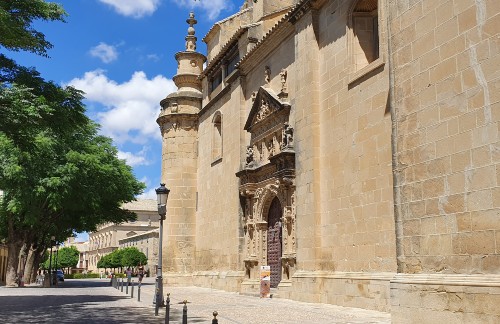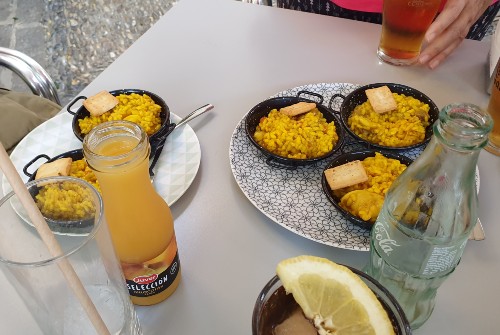One thing that many people worldwide appraise about Spain is probably its architecture. People travel large distances to see Gaudi’s architectural ensembles in Barcelona, especially the Basilica of the Holy Family; Santiago Calatrava’s City of Arts and Sciences in Valencia; and other historical constructions such as the Royal Palace (Madrid), the Royal Site of San Lorenzo de ‘El Escorial’ (monastery 45km away from the capital), or the Alhambra Palace (Granada).

Buildings from different styles and historical periods are spread all over Spain. My hometown, called ‘Ubeda,’ stands out for having a large number of well-preserved architectural monuments from the renaissance period. Located in the middle point of the province of Jaen, Ubeda is a small city that had a big influence in Spain between the 13th and 16th centuries. The city was already an important economic center under the Arab period, and, after the reconquest, it became an important territory for the Castilian Kingdom due to its strategic location between Granada and Castilla. However, it was in the 16th century when Ubeda reached its greatest period. Francisco de los Cobos and Juan Vazquez de Molina, members of the aristocracy of Ubeda, were secretaries of the administration of the Emperor Charles V and Phillip II. Due to the influence of these two personalities, the city became the heart of the Spanish Renaissance and thanks to their influence architecture could flourish.
The most remarkable example of Ubeda’s architecture is located in the Plaza Vazquez de Molina. This square is surrounded by buildings that were built between the 15th and 16th century. Among those we find the funeral chapel of ‘El Salvador,’ Vazquez de Molina Palace which is today’s City Hall, or the basilica of Santa Maria de los Reales Alcazares. The ensemble of renaissance architecture in Ubeda and Baeza is considered one of the most important pieces of renaissance architecture in Spain and Europe. While Baeza’s renaissance architecture was more focused on religion and education (with the cathedral and the university), Ubeda had a large number of palaces for nobility in that period.
In 2003, Ubeda and Baeza were recognized by UNESCO as World Heritage. Since then, in order to commemorate this designation, Ubeda celebrates a Renaissance Festival every year. The renaissance market, the music of the jugglers, and the clothing style bring all the locals back to the past. Celebrated in June, it is an excellent opportunity to extol and admire the beauty of the city.

A City Surrounded by ‘Sea of Olives’
Another aspect that characterizes my hometown is that it is surrounded by a sea of olives. On the outskirts of the city, there is an overlook where you can see a valley replete with olive trees and a landscape that gets lost in the horizon. A large part of the region’s economy comes from the cultivation of olives and the production of olive oil. However, it does not rely only on that. Olive oil has been acknowledged not just for its good properties for diet but also as a good and nutritive ingredient for the skin. And so, many companies manufacture cosmetic products derived from olive oil. In many souvenir shops, you can find local products made of olive oil such as soap, lip balm, hand and body cream, shampoos, and so on.
Olives are an important element of the Spanish diet and cuisine. They are served as an appetizer in almost every bar or restaurant. Olive oil is used for cooking almost every meal. Moreover, olives and olive oil are also symbols of the regional identity. The 28th day of February is the day we commemorate in the Andalusian region. I remember that in school we used to have a piece of bread with sugar and olive oil (a traditional style breakfast) to celebrate this date.
Its Unique Gastronomy
Another thing that cannot be diminished is its regional cuisine. Many Spanish cuisines are common in many regions. However, many areas have their own regional dishes that are not easy to find in other parts of the country. Ubeda also has traditional food that cannot be tasted elsewhere. If you visit the city, I encourage you to try at least one of these dishes. Andrajos, which means ‘old clothes’ in Spanish, is a soup made with tomato, onion, pepper, rabbit meat, and flakes of flour dough. It is common to use hare instead of rabbit and to include cod.

Another traditional food is Ochios which are small loaves of bread that are baked covered with a mixture of paprika and olive oil, and a sprinkle of salt. This gives the bread a dark orange color and a salty flavor once it is baked. This bread can be eaten alone or can be used to make sandwiches. It is usually eaten for breakfast, brunch, or served as a tapa with your drink in some bars. There are in many sizes that range from 7~25 centimeters in diameter. When I was in high-school, I used to eat a medium-size ochio during the lunch break in between classes. But usually, the smallest ones are the ones served as tapas. They are usually filled with deli meat or another traditional dish from Ubeda called morcilla en caldera. It is pork blood fried and cooked with onions, rice, spices, pine nuts, and lard (pork fat). These are just a sample. If you are like me, someone that loves to eat and try new dishes when travelling, I do recommend you take a few days to visit the city and its vicinity so that you have enough time to try different recipes.
Also, a great way to try different types of foods without having indigestion is to go out for tapas. In many cities in the south of Spain, including Ubeda, local people eat tapas. They go to two or three different bars, and they eat with the pieces of food that are given for free with the drinks that they order. Some bars let you choose the tapa, while others just offer a random tapa, with each drink always being accompanied by a different tapa. There is nothing better than sitting on the terrace of a bar on a summer night, drinking a cool beer, and enjoying delicious food while chatting with friends.
By Ines Miranda de Dios, Ph.D. Candidate, Interdisciplinary Program of Global Diaspora Studies

